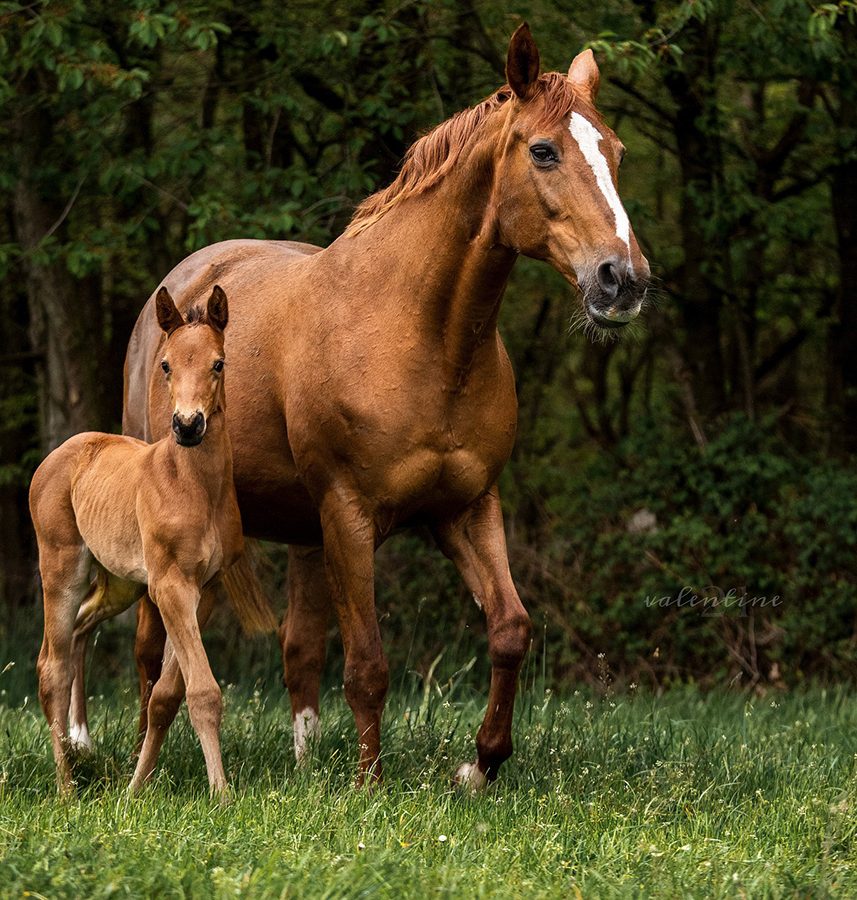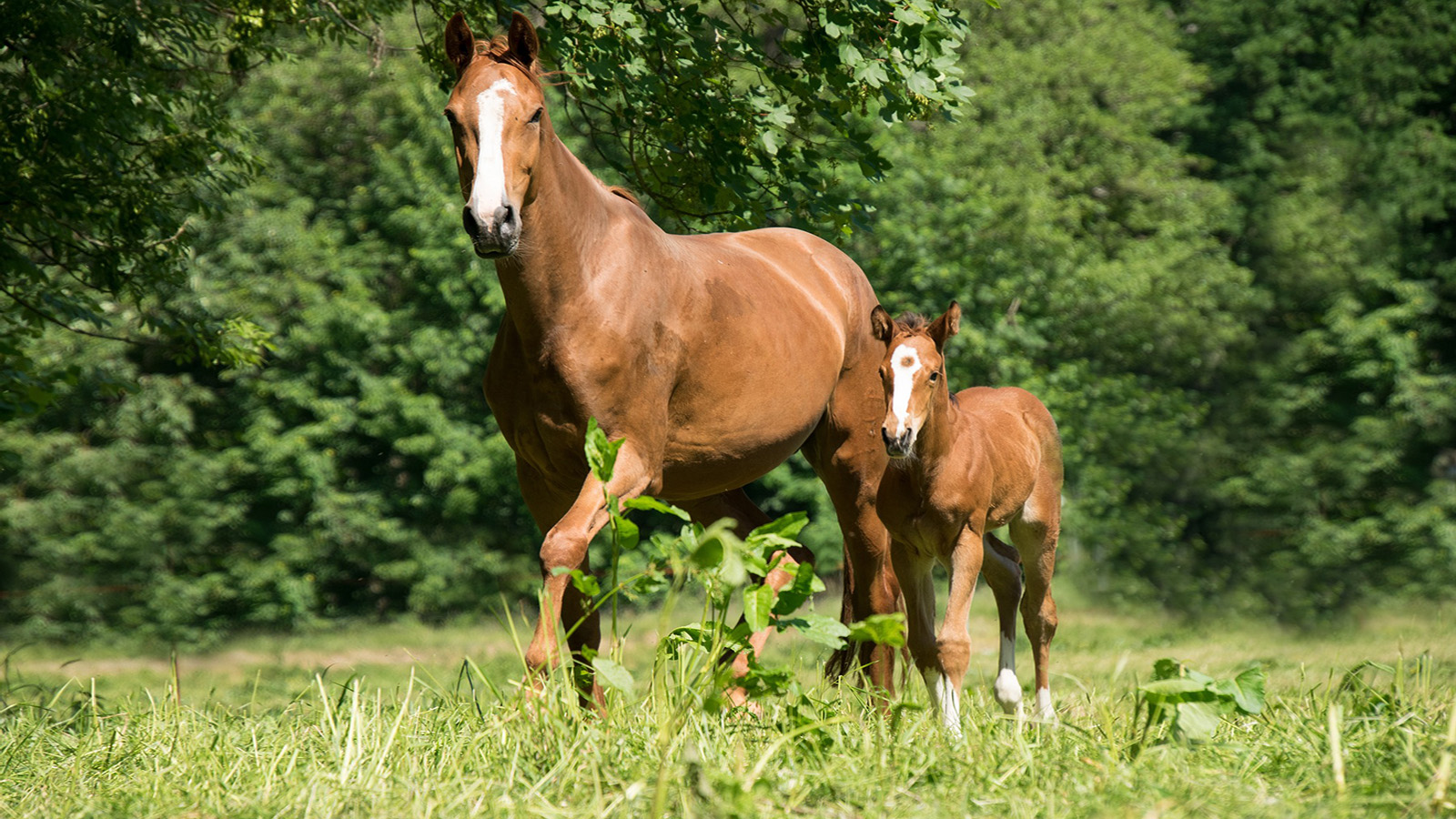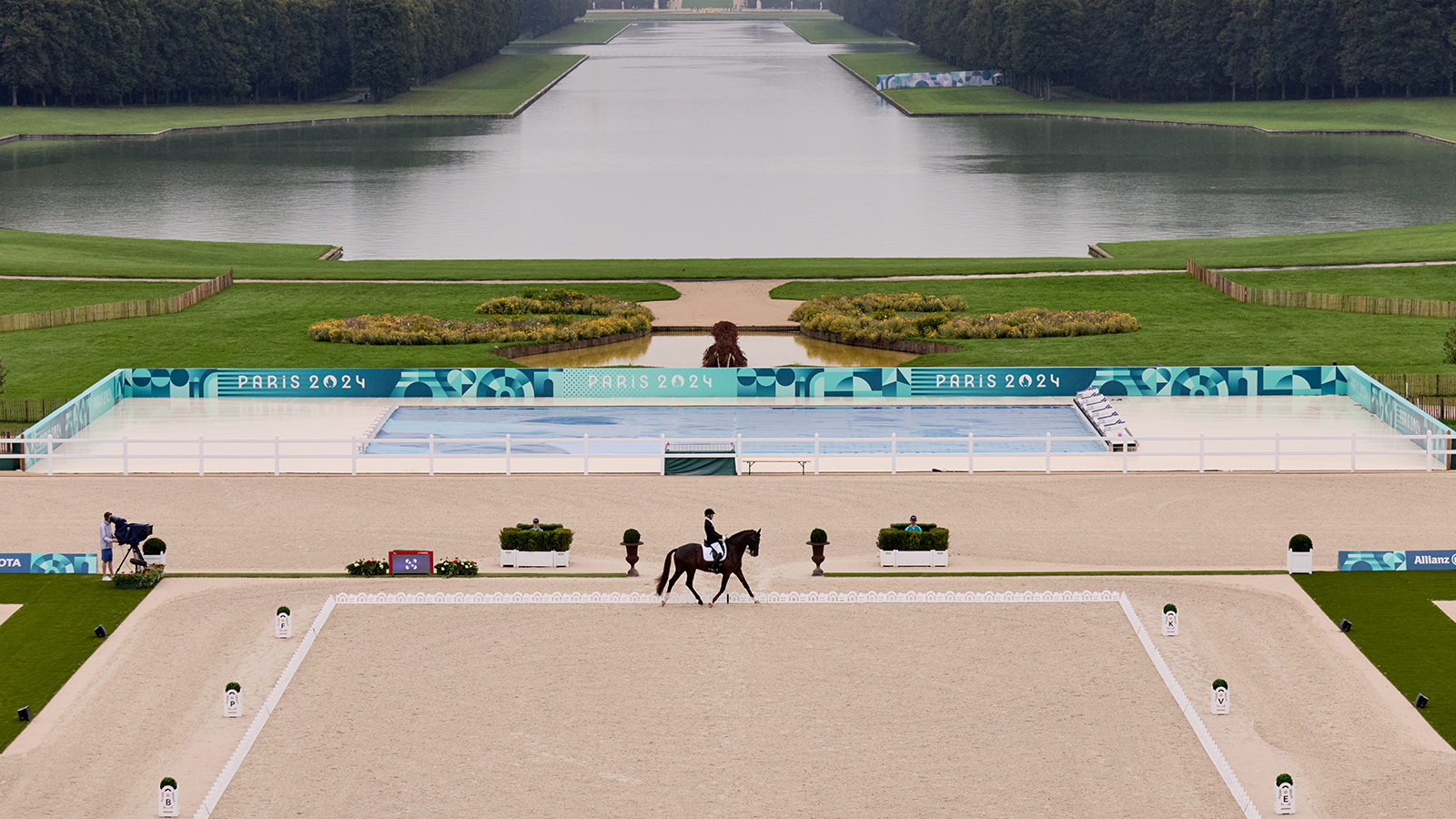With spring officially upon us, the paddocks are full of mares in their last trimester of pregnancy, the stage where the developed foetus increases in size and weight and prepares for birth. While 95 per cent of mares will go through parturition – the birthing process – without any complications and deliver a normal healthy foal, just under 5 per cent will suffer birthing difficulties, some of which will be fatal to the mare, the foal, or sadly both.
Assisting mares during the delivery phase can greatly improve the survival rate of both the mare and the newborn, but unfortunately some mares will still lose their lives and foals will die despite intense intervention by veterinarians and staff.
Parturition usually involves three stages, the first being when the uterine muscles start to have mild contractions, and the mare begins to show signs of restlessness and mild discomfort. Not all mares will display the same signs and sometimes only the astute horse owner will pick up on the impending labour. In some cases the signs can be obvious with the mare pacing the fence, swishing her tail and even looking like she has mild colic. The mare may keep getting up and down or just keep looking at her sides with small areas of sweat apparent on the neck and flanks.
It is during this stage that the foal begins to reposition itself into the “normal” foetal delivery position, with both forelimbs stretched out and pointing toward the vaginal exit and the forehead extended and laying on the extended forelimbs. The hindlimbs should be positioned so that they emerge through the birth canal stifles first and the rest of the hind limbs extended out behind. The cervix is also stimulated to dilate in preparation for the birth during the first stage of labour.

A mare about to give birth. Image by Dr Maxine Brain.

A mare resting with the foal’s hindlimbs still in birth canal. Image by Dr Maxine Brain.
Stage two is the exciting phase where the mare’s water breaks, and the foetus is pushed out through the cervix and vagina into the world. Unlike the first stage of parturition that can take hours or sometimes days, the second stage usually only takes about 20 minutes and for staff or veterinarians watching and/or assisting, it is the most intense and sometimes most stressful part of the procedure. Often mares will get up and down during stage two, and although this can cause concern that the mare is having difficulties, it is a normal part of the birthing procedure.
The front legs should be the first anatomical structure of the foal seen through the vulval lips, with one front limb usually preceding the other by about 10 to15cm. The nostrils of the foal should then be seen coming through the vulval lips followed by the head, neck and shoulders. Typically, the most intense straining by the mare is as the shoulders pass through the pelvis and cervix, as these structures cause a lot of stretching of the tissues as they pass through, stimulating maximum muscle contractions of the uterus. Once the shoulders are through, the thorax (chest) and abdomen follow quickly.
‘QUIET INTERMISSION’
Once the hips pass through the pelvis and out the birthing canal, the mare usually stops the large contractions and lays quietly with the hindlimbs still retained within the birth canal for several minutes. This is thought to allow time for the blood within the placenta and umbilical cord to pass into the foetal circulation before the umbilical cord spontaneously ruptures. However, the value of this quiet intermission is debated by some as to whether it does influence foetal circulation.
“Once the foal has been
delivered, the third stage
of parturition begins.”
Once the foal has been delivered, the third stage of parturition begins, and this involves the passing of the foetal membranes. Whilst the foaling procedure is often thought to be over during this stage, it is still a time when severe complications can occur with the mare and warrants careful observation.
Dystocia is defined as a difficult birth, and the rest of this discussion will concentrate on stage two of parturition where difficulties are encountered during the physical delivery of the neonatal foal.
Unlike cows, it is uncommon for horses to have a dystocia due to a disproportionally large size difference between the foal and the mare. This is because most foals will only develop to a size that allows them to be delivered through the dam’s pelvis (as opposed to cows where using a large bull can result in the calf being physically too big to pass through the pelvis). In mares, dystocias often occur because the foetus has not entered the birthing canal in the correct position and these cases require repositioning of the foetus so the birth can progress.
There are several ways to deal with a dystocia and the method chosen will often depend on the value of the mare and foal, the experience of the veterinarian, the accessibility of a referral hospital and the condition the mare is in when the dystocia is discovered.
To aid in delivery, the veterinarian will often sedate the mare or give her an epidural anesthesia to decrease the strong uterine contractions that might hinder the veterinarian from manually examining the position of the foetus and rendering assistance to help deliver it. When possible, the mare will be anaesthetised, and her hind quarters elevated, to increase the room available within her abdomen to enable successful maneuvering of the foetus. In all cases, the veterinarian should use copious amounts of obstetrical lubricant, increasing the chances of being able to slide one body part relative to another body part far more easily.
THREE PRINCIPAL CHOICES
The three principal choices of dealing with a dystocia are: manual manipulation of the foal to aid delivery; caesarian to remove the foetus via surgery; or a foetotomy, which is the dissection of the foal within the uterus to aid its removal from the mare. Ideally, most dystocias would be resolved with manual manipulation to allow a quick, non-invasive solution; however, as the dystocia becomes more complicated, the need for more intense intervention occurs.
Caesarians are generally used when the foetus is alive, and the value of the mare and foal warrants surgical intervention. The mare must be able to be transported to an equine surgical facility to be able to have a caesarian, therefore it is important that a decision to do surgery is made quickly, as mares that have been down and straining for extended periods cannot always stand and be transported. Successful caesarians performed in the field are rare due to the high risk of infections and the need for intensive treatment on both the mare and foal post-surgery.
A foetotomy is used when the foetus has already passed away. It is not always an ideal procedure, as damage can be done to the mare and to her cervix, which can compromise future pregnancies. Unfortunately, they are unavoidable in some circumstances, as there are few options available when the foal cannot be removed intact, and if not delivered the mare’s health is severely compromised.
Traction – or just physically pulling the foetus – could also be listed as a method of dealing with a dystocia but should not be done unless the foal is correctly positioned, as the mare’s uterus can be damaged if the limbs are incorrectly positioned and brute strength is applied. That said, it is a good adjunct to manual manipulation but should only be used in unison with the mare’s natural uterine contractions. The exception to this is the scenario where a mare has been exhausted from a prolonged birth, or has poor uterine contractions, and traction is all that is required for the foal to be delivered. Where possible, the traction is still timed to coincide with the mare’s albeit poor contractions.

A newborn foal standing for the first time.
COMMON TO BECOME STUCK
It is common for the foetus to become stuck at the shoulders or in hip lock when the mare is young (immature in her pelvic size), or the foetus does not present correctly during delivery, allowing the shoulders or hips to pass through squarely and not on a slight angle as would normally occur. By this I mean that when the foal is normally presented, one front leg is presented further advanced than the other and this correlates with one shoulder passing through the pelvis slightly before the other shoulder, making the width of the foal less than it would be if both shoulders came through at the exact same time.
Similarly, the hips of the foal can become locked at the mare’s pelvis, and if the correct steps aren’t taken it can result in the foal’s pelvis wedged solidly in the mare’s pelvis, causing death to the foal and sometimes the mare. When faced with these dilemmas, an exuberant owner should not simply grab both front legs and pull as this can cause further wedging until it is impossible to uncouple the two. Instead, when faced with shoulder lock, the limbs should be pulled gently one at a time, encouraging the shoulder joints to pass through one at a time to reduce the width through the shoulder area.
“Prompt and early intervention
can optimise the survival
of the mare and foal.”
Veterinarians will often need to use a large amount of obstetrical lubricant to increase the likelihood of the shoulders sliding through, as once the normal birthing fluids have passed the foal becomes dry and more resistant to gliding smoothly through the passage. In the case of the hips, this procedure can be far more difficult as the tendency is just to keep pulling. Instead, the veterinarian needs to disengage the hips if wedged, by maneuvering the foal around at the same time as introducing plenty of obstetrical lube, so the hips can be manipulated enough to slide through and out.
Simple dystocias are those where the vet can perform an easy manipulation that results in the foal being delivered both quickly and safely. Examples of these are where a front fetlock or a knee may be flexed, and the vet is able to straighten the limb with careful manipulation so the foal can be delivered as normal. The difficulty increases when both forelimbs are involved but the vet needs to address each limb separately, trying to convert a mispositioned limb into a straight limb. This can often involve the vet needing to push one limb back into the uterus to create the room to move and replace the other flexed limb so both limbs can be arranged in the correct position.
It is important for the vet to preplace ropes or straps onto any limbs before pushing them backwards so that they don’t lose the ability to be able to pull this limb forward when needed – nothing is worse than losing access to a limb that was previously in reach. Flexed limbs can occur at any joint along the limb, with sometimes the flexion occurring at the shoulder, which means the lower part of the limb is completely out of reach for the vet.
On some occasions, where both forelimbs are flexed at the knee or higher up the limb, the first part of the foal to be seen through the vulval lips is the head. This is a very dangerous scenario as the foal can die very quickly due to asphyxiation. Once again, the vet must try to push the foal back inside the mare to enable access to the front limbs and try to manipulate these limbs into a position that enables the foal to pass through the birth canal.

Whilst we cannot prevent a dystocia from occurring, prompt and early intervention can optimise the survival of the mare and foal.
A CHALLENGE TO THE VET
There is a condition seen in some foals where the knees are flexed because of contracted tendons, making it physically impossible to straighten the limbs. This can be very difficult for the vet to manage and may require the foal to be delivered with the knees flexed. Not only is this a challenge to the vet, but it can also be exceedingly frustrating for them when they deliver a live foal that cannot stand and drink due to the deformities in their limbs. Foals born healthy with contracted tendons can often be saved if the tendons can be relaxed with a combination of bandaging and medications or with surgery performed to cut the offending contracted tendons. Therefore, it is worth trying to deliver a live foal that has contracted tendons, when possible.
There are other types of foal deformities that are incompatible with life, and will cause a dystocia, necessitating veterinary involvement to save the mare. One example is foals born with hydrocephalus. In these cases, the foal’s head can become too large to be delivered naturally and even if delivered alive, the foal will not survive. Other deformities can include ankylosed or fused joints that will not allow the limbs to be straightened, or the neck to be fixed in a twisted position that prevents delivery.
Complicated dystocias can involve many other malpositions such as the foetus coming out hindquarters first, the foetus on the side so that the back is across the pelvis, the head and neck turned back, or the head flexed at the poll. The degree of flexion, the size of the foetus and the ability of the veterinarian will dictate how these dystocias are handled, but the principles will be the same in trying to save the mare and foal.
One of the worse types of dystocia I have had to deal with is when the mare presents with a foal in the “dog sitter” position. These are foals where the hind limbs are positioned forward so that when the vet assesses the mare during birth, the head and front limbs are as they should be, but the feet of the hind limbs are also coming through the pelvis. For larger foals, these can be near impossible to manipulate so the foal can be delivered through the vagina. When identified early, if the mare and foal are valuable, an early caesarian can be the best resort to try and save both mare and foal. If the foal has already died, then some veterinarians will try and do a foetotomy. It is a dystocia that can unfortunately end with both the loss of the mare and foal.
One cause of dystocia that shouldn’t occur but occasionally does is the presentation of twin foetuses. Whilst the likelihood of twins has diminished significantly with early pregnancy scanning, there are occasions when a twin is missed or the mare is not scanned. If the mare does not abort both foetuses when less than full term, and the foals are carried to term, they can cause a dystocia with limbs of both foals entangled as they are being delivered. In this circumstance, the veterinarian needs to identify that the mare has twins and reposition one foal so that the other can be delivered first. Usually, a twin foetus is smaller than a singular foal, so once the limbs have been repositioned with two front legs and a head belonging to the one foal in the birth canal, then delivery is quickly facilitated.
Whilst we cannot prevent a dystocia from occurring, prompt and early intervention can optimise the survival of the mare and foal, and for this reason mares should be supervised when foaling wherever possible.
The use of foaling alarms to alert the owner to an impending birth may also provide the opportunity for a veterinarian to be called if the owner identifies the mare is struggling to deliver a foal in a timely manner or sees the wrong part of a foal emerging through the vulval lips. Mares should also be kept in good physical order, not too fat and not too weak to enable them to have the strength and fitness to endure a birth.
I would strongly encourage any owners that are expecting their first foal to go and source videos of a normal birth procedure prior to their delivery. Knowing how a normal birth proceeds will greatly help identify a possible dystocia, enabling a quick response to a potentially disastrous scenario, with time a crucial element of success.EQ





